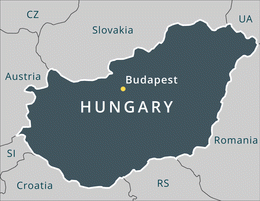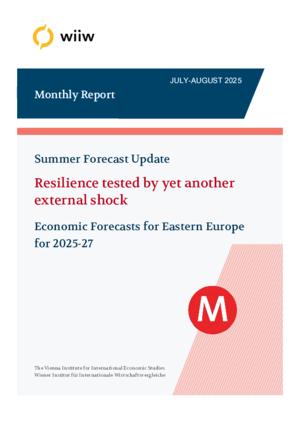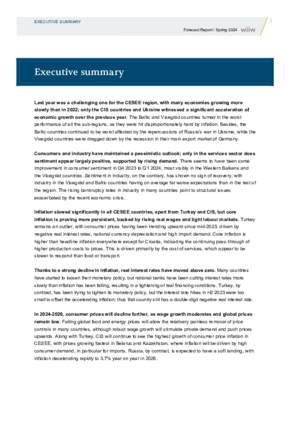Hungary

In Q1 2025, GDP fell by 0.4% year on year. The performance of industry and construction declined considerably; that of agriculture marginally. A modest 1.1% expansion in the largest sector – services – saved the economy from an even bigger decline. Final consumption increased by 3%; gross fixed investment recorded a large fall of 10.1%, partly on account of reduced EU transfers. Both exports and imports virtually stagnated (net exports were marginally negative). Disinflation has not gone according to plan: in May, the consumer price index was 4.5% and core inflation 4.8%. By April, the economy had accumulated 71% of the fiscal deficit envisaged for the full year. There is no sign yet of a positive turnaround in the disappointing overall economic performance. Price caps to curb inflation only hide the inflationary pressure. The ruling Fidesz party’s poor showing in public opinion polls ahead of the general election in less than a year makes it highly unlikely that there will be any improvement in the fiscal balance, as Prime Minister Orbán will most likely resort to his tried-and-tested strategy from previous election campaigns of issuing handouts at the expense of fiscal balance. Nevertheless, the second half of the year could bring some improvement to the economic performance, provided a few large foreign investments in the automotive and battery-manufacturing sectors come to fruition. The chaotic conditions currently prevailing in global trade – especially in the automotive industry – render the market prospects for goods produced in the new capacities highly uncertain. Overall, GDP growth for this year is expected to be around 0.7%; the years 2026 and 2027 could see a somewhat better growth performance in excess of 2%.
| |
|
|
|
FORECAST* |
| Main Economic Indicators | 2022 | 2023 | 2024 | 2025 | 2026 | 2027 |
| Population, 1000 persons | 9605 | 9592 | 9562 | . | . | . |
| GDP, real change in % | 4.3 | -0.8 | 0.5 | 0.7 | 2.2 | 2.0 |
| GDP per capita (EUR at PPP) | 27590 | 29440 | 30500 | . | . | . |
| Gross industrial production, real change in % | 6.1 | -5.5 | -4.0 | . | . | . |
| Unemployment rate - LFS, in %, average | 3.6 | 4.1 | 4.5 | 4.2 | 4.0 | 4.5 |
| Average gross monthly wages, EUR | 1278 | 1496 | 1636 | . | . | . |
| Consumer prices, % p.a. | 15.3 | 17.0 | 3.7 | 5.0 | 4.5 | 3.5 |
| Fiscal balance in % of GDP | -6.2 | -6.8 | -4.9 | -5.3 | -5.3 | -4.0 |
| Public debt in % of GDP | 73.9 | 73.0 | 73.5 | . | . | . |
| Current account in % of GDP | -8.5 | 0.3 | 2.2 | 1.5 | 1.7 | 1.8 |
| FDI inflow, EUR m | 14098 | 4378 | 4189 | . | . | . |
| Gross external debt in % of GDP | 91.9 | 85.8 | 84.7 | . | . | . |
Basic data are continuously updated.
* Forecasts are changed beginning of January, April, July and November.
See Press Conferences.
publication_icon
Monthly Report No. 7-8/2025
Vasily Astrov, Alexandra Bykova, Selena Duraković, Meryem Gökten, Richard Grieveson, Maciej Grodzicki, Ioannis Gutzianas, Doris Hanzl-Weiss, Gabor Hunya, Branimir Jovanović, Niko Korpar, Dzmitry Kruk, Sebastian Leitner, Isilda Mara, Emilia Penkova-Pearson, Olga Pindyuk, Sandor Richter, Marko Sošić, Bernd Christoph Ströhm and Maryna Tverdostup
wiiw Monthly Report No. 7-8, July-August 2025
38 pages including 5 Tables and 3 Figures
Details
publication_icon
Executive summary
Olga Pindyuk
in: The Crisis is Over, but its Scarring Effects are Hindering Recovery
wiiw Forecast Report No. Spring 2024, April 2024 , pp. I-VII
Details
In Q1 2025, GDP fell by 0.4% year on year. The performance of industry and construction declined considerably; that of agriculture marginally. A modest 1.1% expansion in the largest sector – services – saved the economy from an even bigger decline. Final consumption increased by 3%; gross fixed investment recorded a large fall of 10.1%, partly on account of reduced EU transfers. Both exports and imports virtually stagnated (net exports were marginally negative). Disinflation has not gone according to plan: in May, the consumer price index was 4.5% and core inflation 4.8%. By April, the economy had accumulated 71% of the fiscal deficit envisaged for the full year. There is no sign yet of a positive turnaround in the disappointing overall economic performance. Price caps to curb inflation only hide the inflationary pressure. The ruling Fidesz party’s poor showing in public opinion polls ahead of the general election in less than a year makes it highly unlikely that there will be any improvement in the fiscal balance, as Prime Minister Orbán will most likely resort to his tried-and-tested strategy from previous election campaigns of issuing handouts at the expense of fiscal balance. Nevertheless, the second half of the year could bring some improvement to the economic performance, provided a few large foreign investments in the automotive and battery-manufacturing sectors come to fruition. The chaotic conditions currently prevailing in global trade – especially in the automotive industry – render the market prospects for goods produced in the new capacities highly uncertain. Overall, GDP growth for this year is expected to be around 0.7%; the years 2026 and 2027 could see a somewhat better growth performance in excess of 2%.


